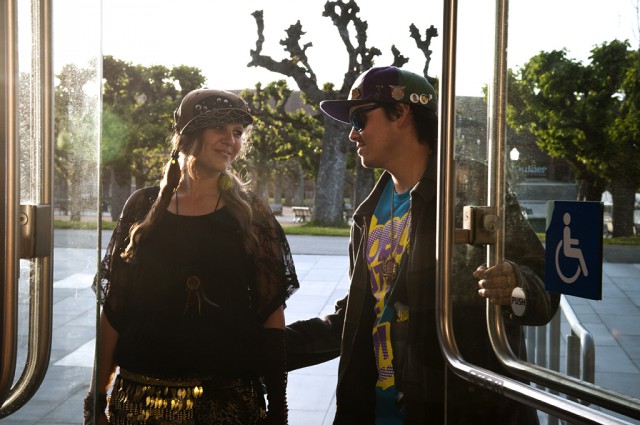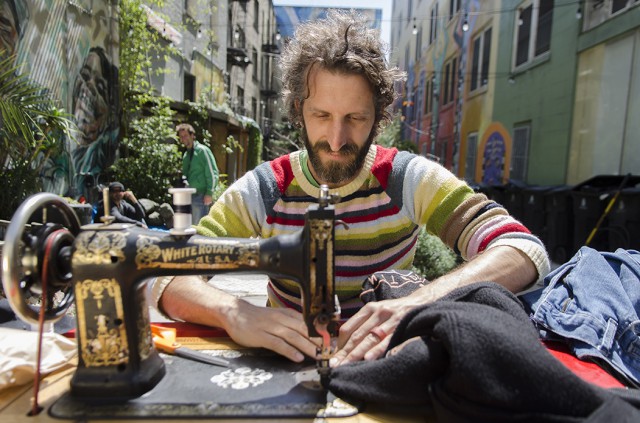
Written by Lissette Alvarez
Photos by Godofredo Vasquez
The smell of bagels and coffee float in the air, as R&B and laughter emanate through the sitting area in the Sala Burton Residence. 72-year-old Beverly Saba, the president of the Sala Burton Tenant Association, wears her hair in a loose, white bun which reflects her soft yet authoritative demeanor.
The table is a schmorgesborge of salad, yogurt, pasta, and fruit, while the couch next to the table overflows with bagels and other pastries. San Francisco’s senior citizens line up by the table, eating utensils in hand, ready to bask in the buffet in front of them. Saba observes her tenants as they prepare dinner, and makes sure everyone gets their fair share.
Carrillo Marco, 61, walks with his long wooden cane. Marco’s long hair, tied back in a ponytail, is white enough to rival Saba’s and makes his leathery skin appear darker in contrast. Saba frowns as they begin to discuss the quality of the food. She chides him for not having anything positive to say. He rolls his eyes and ignores the elderly woman’s comments. As Saba continues to push Marco’s buttons, he eventually caves in.
“Okay, okay,” he gruffly says. “I’ll admit the food program is a blessing in disguise, especially considering most of us can’t afford stuff like Whole Foods and Trader Joe’s.”
The Sala Burton Tenant Association is one of the few organizations that offer free food to the elderly and disabled. Saba began the free food program four years ago after becoming president of the association. The program is an attempt to alleviate the economic and geographic problems her low-income tenants face in their hunt for nutritional food items.
“When you live in a neighborhood like the Tenderloin, people try to size up our living situation,” says Saba. “We [the tenant association] try to make it a positive experience for everyone.”
Food insecurity in America is common among households with incomes below the federal poverty line, particularly in African American and Hispanic households as well as those ran by a single mother. The city is witnessing a dramatic increase in the demand for food and healthy services provided by both federally-funded nutrition programs and community-based food programs, according to the San Francisco Food Security Task Force Annual Report.

Although the city does offer several food programs such as Pantry Network and Shopping Program, Saba still feels the city could do more for the elderly.
“The Tenderloin isn’t exactly a friendly neighborhood for the elderly,” she says. “I would like to see bigger, inexpensive grocery stores like Costco or Foods Co built around here. The alternative would be to have the food delivered, which has actually saved us a lot of money.”
A huge bulk of Sala Burton’s food comes from Food Runners – one of the most successful food organizations in San Francisco. The mission of Food Runners is to help alleviate hunger in San Francisco, prevent waste, and create community. Food Runners is a California 501.C3 Corporation – with a Board of Directors and an Advisory Committee made of concerned individuals from throughout the community.
“We frame and define hunger in San Francisco as lack of access by all people at all times to enough nutritious food for an active healthy life,” explains Nancy Hahn, who has been Food Runners’ volunteer coordinator for nine years.
Food Runners currently delivers approximately ten tons of food per week, which would have otherwise been thrown away. The organization delivers to over a hundred agencies serving those in need. With help from Hahn and other volunteers, they are able to provide enough food for two thousand meals a day in San Francisco. The organization’s primary donors include farmers markets’, Trader Joe’s, Kaiser, and Twitter.
“We usually bring in fresh fruits, vegetables and other organic food items,” says Hahn. “You know, stuff I would feed my kids.”
The annual report also reveals that one in five adults in San Francisco struggle each day to feed themselves and their families. Food often becomes a nonessential item if a person with a limited income must choose between paying rent and buying food.
Low-income seniors and disabled residents are some of the more vulnerable groups in San Francisco due to their special needs, inadequate or nonexistent incomes, rules governing the Supplemental Security Income program in California, and a lack of dedicated public funds.
Paula Jones, director of the food task force, points out that the city’s most vulnerable residents rely on a network of food programs that are often supported by both public and private funds. This public/private model provides the foundation with a sustainable community based food system. As the need for food resources increases, however, community-based food programs are challenged to be able to meet the growing demand. As local public funds for food programs decline, community-based organizations increasingly rely on private donations to fund a larger portion of these programs.
Many organizations and individuals in San Francisco contribute to the improvement of food security and nutrition of vulnerable residents, according to Jones. The city’s urban agriculture program has also contributed over seventeen thousand pounds of fresh produce to those in need and continues to thrive.
Back at the Sala Burton Residence the dinner table is left with nothing but a large pile of bagels. Burton and her tenants sit and watch the clock, and wait for their next delivery.






Batam Dine • Apr 26, 2016 at 1:08 am
Beautiful article and beautiful website by the way. Lovely to see elderly got some produces for them to eat. They deserved it.
Logan Versluis • May 7, 2013 at 4:35 am
Bonjour à tous, Ashley ici comment sommes-nous tous?